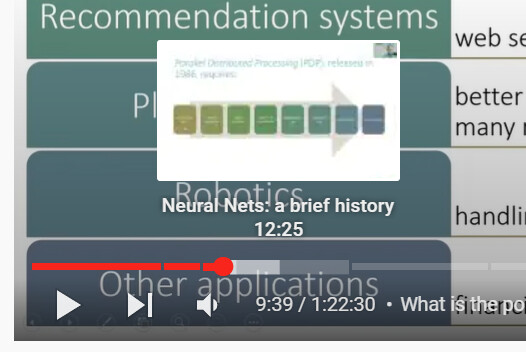Lecture 2 (revised on May 23st)
Let’s turn your model into a web app
00:00 New exciting content to come
- Can there be substantial new content given we have already 4 versions and a book?
00:57 Ways of reading the book
- How many channels available for us to read the book? (physical, github, colab and others)
01:28 Extra sweets from the book
02:06 aiquizze.com
- Where can you get more quizzes of fastai and memorize them forever?
02:38 Introducing the forum
- How to make the most out of fastai forum?
04:12 Students’ works after week 1
06:08 A Wow moment
- Will we learn to put model in production today?
06:46 Find a problem and some data
- What is the first step before building a model?
07:07 Access to the magics of Jupyter notebook
-
Do you want to navigate the notebook with a TOC? #jupyter
-
How about collapsable sections?
-
How about moving between start and end of sections fast?
-
How to install jupyter extensions
09:48 Download and clean your data
11:06 Get to docs quickly
- How to get basic info, source code, full docs on fastai codes quickly?
12:40 Resize your data before training
-
How can you specify the resize options to your data? #code
-
Why should we always use RandomResizedCrop and aug_transforms together? #best-practice
-
How RandomResizedCrop and aug_transform differ?
16:56 Data images instantly transformed not copied
- When resized, are we making many copies of the image? #best-practice
17:54 More epochs for fancy resize
- How many epochs do we usually go when using RandomResizedCrop and aug_transforms? #best-practice
18:58 Confusion matrix: where do models get wrong the most?
-
How to create confusion matrix on your model performance? #code
-
When to use confusion matrix? (category) #best-practice
-
How to interpret confusion matrix?
-
What is the most obvious thing does it tell us? #question
-
How hard is it to tell grizzly and black bears apart?
20:22 Check out images with worse predictions
-
Do plot_top_losses give us the images with highest losses? #code
-
Are those images merely ones the model made confidently wrong prediction? #best-practice
-
Do those images include ones that the model made right prediction unconfidently?
-
What does looking at those high loss images help? (get expert examination or simple data cleaning)
22:08 What if you want to clean the data a little
-
How to display and make cleaning choices on each of those top loss images in each data folder? #best-practice
-
Without expert knowledge on telling apart grizzly and black bears, at least we can clean images which mess up teddy bears.
24:44 Myth breaker: train model and then clean data
25:23 Turn off GPU when not using
- How to use GPU RAM locally without much trouble?
26:17 Watch first, then watch and code along
- What is the preferred way of lecture watching and coding by majority of students?
27:19 A Gradio + hugging face tutorial
30:19 Git and Github desk
- Is Github desk a less cool but easier and more robust way to version control than git?
31:31 Terminal for windows
29:00 Get started with Hugging Face Spaces
33:45 Get the default App up and running
-
How to use git to download your space folder?
-
How to open vscode to add app.py file?
-
How to use vscode to push your space folder up to hugging face spaces online?
-
then go back to your space on Hugging Face to see the app running
37:10 Train and download your model
-
Where is the model we are going to train and download from Kaggle notebook?
-
How to export your model after trained it on Kaggle? #code
-
Where do you download the model?
-
How to open a folder in terminal? open .
-
Make sure the model is downloaded into its own Hugging Face Space folder
41:15 Predict with loaded model
-
How to load downloaded model to make prediction? #code
-
How to make prediction with the loaded model?
-
How to export selected cells of a jupyter notebook into a python file?
-
How to see how long a code runs in a jupyter cell?
44:22 Turn your model into Gradio App locally
-
How to prepare your prediction result into a form gradio prefers? #gradio #code
-
How to build a gradio interface for your model?
-
How to launch your app with the model locally?
-
Not in video: run the code on Kaggle in cloud
48:25 Push this app onto Hugging Face Spaces
-
Make sure to create a new space first, e.g., testing
-
How to turn the notebook into a python script?
-
How to push the folder up to github and run app in cloud?
-
Not in Video: if stuck, check out Tanishq tutorial #trouble-shooting
51:46 How many epochs are ideal for fine tuning?
#best-practice #fine-tuning
53:15 How to save model from colab?
54:24 How to install fastai properly
-
#installation #trouble-shooting #code
-
How to download github/fastai/fastsetup using git? git clone https://github.com/fastai/fastsetup.git
-
How to download and install mamba? ./setup_conda.sh
-
Not in Video: problem of running ./setup_conda.sh
-
How to download and install fastai? mamba install -c fastchan fastai
-
How to install nbdev? mamba install -c fastchan nbdev
-
How to start to use jupyter notebook? jupyter notebook --no-browser
-
Not in Video: other problem related to xcode
59:48 The workflow summary
01:01:04 HuggingFace API + gradio + Javascript = real APP
01:02:42 How easy does HuggingFace API work
01:04:43 How easy to to get started with JS + HF API + gradio
01:07:20 App example of having multiple inputs and outputs
01:08:09 App example of combining two models
01:09:28 How to turn your model into your own web App with fastpages
01:14:09 How to fork a public fastpages for your own use
Common problems Not in Video


